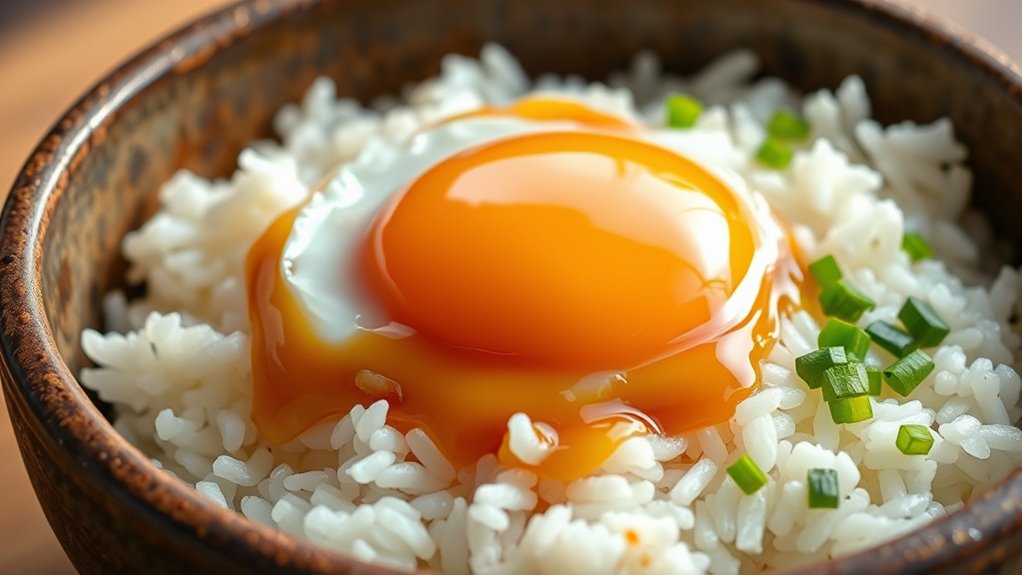Tamago kake gohan is a classic Japanese comfort dish that combines hot steamed rice, a raw egg, and soy sauce. You crack the egg over the rice, gently mix, and enjoy the creamy, flavorful result. It’s simple, emphasizing freshness and minimal ingredients, and reflects Japan’s values of resourcefulness and seasonality. If you’re curious about how this humble dish became a beloved staple, keep exploring to discover its rich cultural roots and variations.
Key Takeaways
- Tamago Kake Gohan is a traditional Japanese dish combining hot rice, raw egg, and soy sauce, emphasizing simplicity and comfort.
- It originated post-WWII, symbolizing resourcefulness and home-cooked values in Japanese culture.
- Preparation involves mixing a fresh, raw egg with hot rice and seasonings, served immediately for optimal texture.
- Variations include toppings like green onions, sesame seeds, or proteins, allowing customization.
- The dish offers nutritional benefits, including essential amino acids and vitamins, with careful attention to egg freshness.
The Origins and Cultural Roots of Tamago Kake Gohan
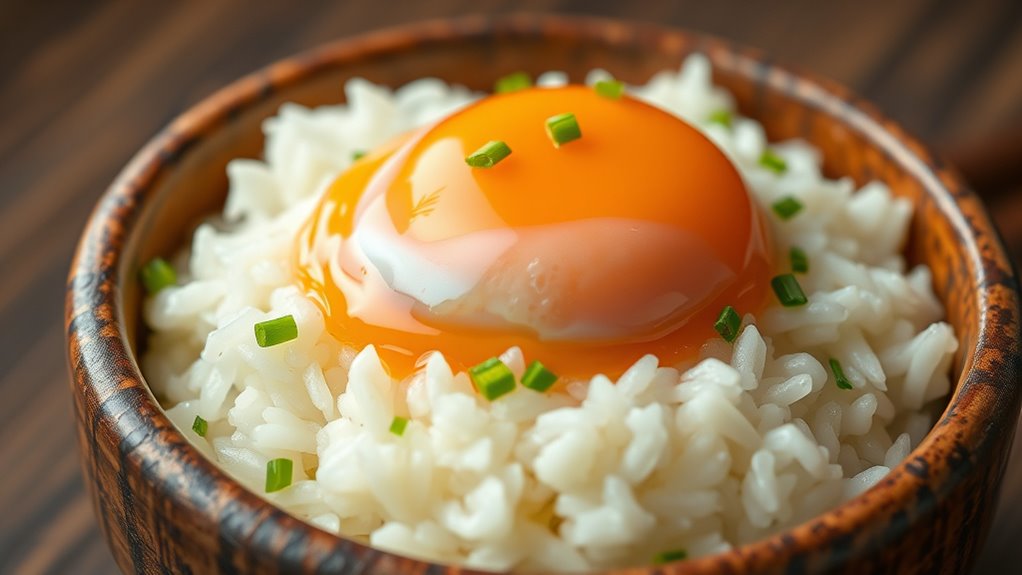
Tamago Kake Gohan, a simple yet beloved Japanese dish, has deep roots in Japan’s culinary history and culture. You’ll find it’s been a staple in Japanese households for generations, valued for its quick preparation and comforting taste. Its origins trace back to post-war Japan, when resourcefulness and simplicity shaped everyday meals. People embraced this dish because it’s easy to make with basic ingredients, reflecting Japan’s emphasis on minimalism and seasonality. Over time, Tamago Kake Gohan became more than just a quick breakfast; it symbolizes home cooking, family traditions, and the importance of appreciating humble, everyday foods. Additionally, the dish’s cultural significance highlights its role in fostering a sense of community and continuity among generations. Today, it remains an enduring cultural icon, connecting past and present through its simple yet meaningful flavors.
Key Ingredients and Variations of the Dish

You’ll want to start with the classic ingredients like fresh rice, a raw egg, and soy sauce. But don’t hesitate to get creative with add-ins like green onions, sesame seeds, or even butter. Exploring different variations can turn a simple dish into something uniquely yours. Incorporating grocery savings strategies can also help you find quality ingredients at a lower cost. Considering tuning the flavor profile by adjusting seasonings can further elevate your tamago kake gohan experience.
Classic Tamago Kake Gohan Ingredients
At its core, classic Tamago Kake Gohan hinges on a few simple ingredients that come together quickly to create a comforting dish. The main component is a fresh, high-quality raw egg, which you crack directly onto steaming hot rice. The heat slightly cooks the egg, creating a creamy texture. You’ll also need freshly cooked, plain white rice—preferably warm—to blend with the egg smoothly. A splash of soy sauce is essential for seasoning, adding saltiness and umami. Some people like to include a pinch of salt or a dash of sesame oil for extra flavor. These ingredients form the foundation of traditional Tamago Kake Gohan, emphasizing simplicity and freshness. Ingredient quality can make a significant difference in flavor. Using fresh, high-quality ingredients ensures the most authentic and flavorful experience. Variations may exist, but these key elements remain constant to deliver the dish’s authentic taste. For an authentic experience, using fresh, high-quality ingredients can make a significant difference in flavor.
Creative Variations and Add-ins
Creative variations and add-ins allow you to customize Tamago Kake Gohan to suit your taste. You can experiment with different toppings like chopped scallions, shirasu, or pickled vegetables for added flavor. Mixing in a dash of soy sauce or a sprinkle of sesame seeds enhances the dish’s umami. Some enjoy adding a little butter or mayonnaise for creaminess, while others prefer a splash of hot sauce or chili flakes for heat. For a more filling version, toss in cooked salmon flakes or seasoned ground meat. Vegetables like grated daikon or kimchi can add crunch and tang. Additionally, changing gears smoothly while preparing or serving can help you enjoy your meal more comfortably. Incorporating proper storage techniques ensures your ingredients stay fresh and safe to use. These variations let you personalize your Tamago Kake Gohan, making each bowl uniquely delicious and tailored to your preferences.
Step-by-Step Guide to Preparing Perfect Tamago Kake Gohan
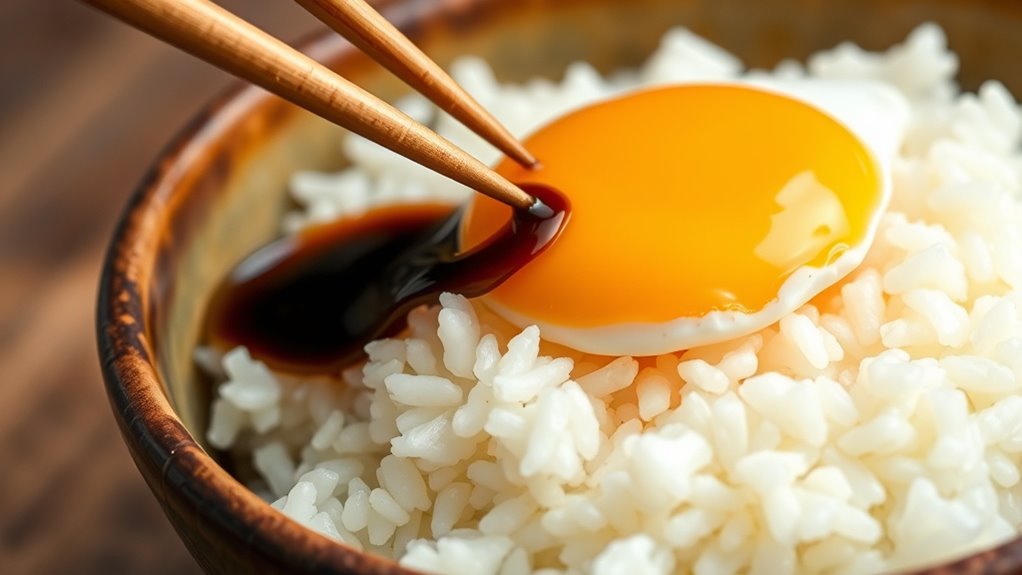
To make perfect Tamago Kake Gohan, start by selecting fresh, high-quality eggs and steaming or boiling your rice until it’s fluffy and hot. Crack the egg into a small bowl, then beat it gently with chopsticks or a fork until well combined. In a separate bowl, scoop in the hot rice. Pour the beaten egg over the rice, ensuring it’s evenly distributed. Gently mix everything together using a spoon or chopsticks, allowing the heat to slightly cook the egg and create a creamy texture. Taste and adjust with a pinch of salt if desired. Serve immediately for the best flavor and texture. Keep in mind, the key is using hot rice and fresh eggs for a silky, satisfying dish. Additionally, using a high-quality projector can help you enjoy your favorite movies and shows in stunning clarity, enhancing your overall home dining and entertainment experience. Proper placement of your entertainment setup can further elevate your meal times into a cozy, enjoyable experience. Incorporating AI-driven solutions in food preparation techniques is increasingly influencing modern culinary practices.
Tips for Enhancing Flavor and Texture
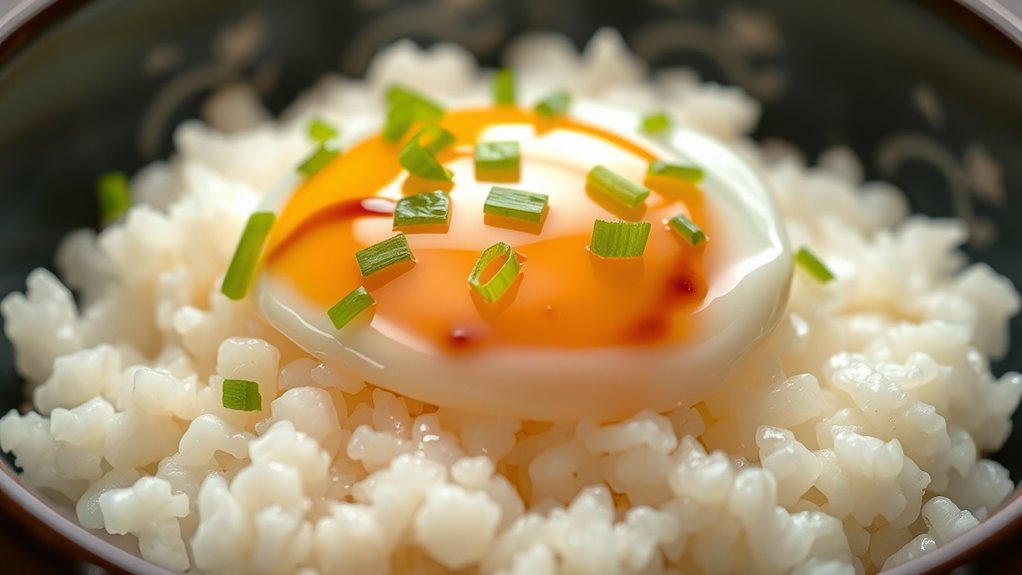
To boost the flavor and texture of your Tamago Kake Gohan, try adding different seasonings like soy sauce, sesame oil, or a dash of mirin. You can also experiment with toppings such as green onions, nori, or even a soft-boiled egg for added richness. These simple tweaks will give your dish more depth and a satisfying variation in every bite. Incorporating regional flavors and traditions can further enhance your culinary experience.
Seasoning Variations for Depth
Enhancing the flavor and texture of tamago kake gohan can be achieved by experimenting with different seasoning variations. Try adding a dash of soy sauce for umami richness, or sprinkle in some sesame oil for a nutty aroma. A touch of mirin can introduce subtle sweetness, balancing the savory elements. For a spicy kick, include a few drops of chili oil or a small amount of shichimi togarashi. You can also incorporate minced green onions or grated ginger to add freshness and depth. Incorporating aesthetic serveware can elevate the presentation of each bowl, making the experience more visually appealing. Understanding keto diet principles can inspire innovative ways to enhance your culinary techniques, such as utilizing precise measurements or systematic flavor testing. Paying attention to seasoning balance helps ensure that no single flavor overwhelms the dish, creating a harmonious taste. Experimenting with these seasonings allows you to customize each bowl, elevating the simple dish into a more complex and satisfying experience. Just remember to start small and adjust to taste, as even minor changes can make a big difference. Incorporating proper cleaning techniques can also ensure that your utensils and serving ware remain in top condition, maintaining the dish’s presentation and flavor integrity.
Texture Enhancement Techniques
Adding contrasting textures can markedly elevate tamago kake gohan. To achieve this, consider incorporating ingredients that add crunch, creaminess, or chewiness. For example, a sprinkle of toasted sesame seeds offers a satisfying crunch, while a spoonful of creamy miso adds richness. You can also mix in chopped scallions for a fresh bite or crispy tempura bits for added texture variety. Using organic ingredients ensures that your toppings are fresh and free from pesticides, enhancing both flavor and health benefits. Incorporating wider tires for better grip can also inspire new flavor pairings with your rice dish, creating a delightful fusion experience. Additionally, experimenting with different texture-enhancing ingredients can help tailor the dish to your personal taste preferences. Incorporating a variety of textural contrasts can make each bite more interesting and satisfying. Here’s a quick overview:
| Texture Type | Ingredient Option | Effect |
|---|---|---|
| Crunchy | Toasted sesame seeds | Enhances bite and aroma |
| Creamy | Miso paste | Adds smooth richness |
| Chewy | Seaweed strips | Introduces a subtle chewiness |
The Nutritional Benefits and Considerations
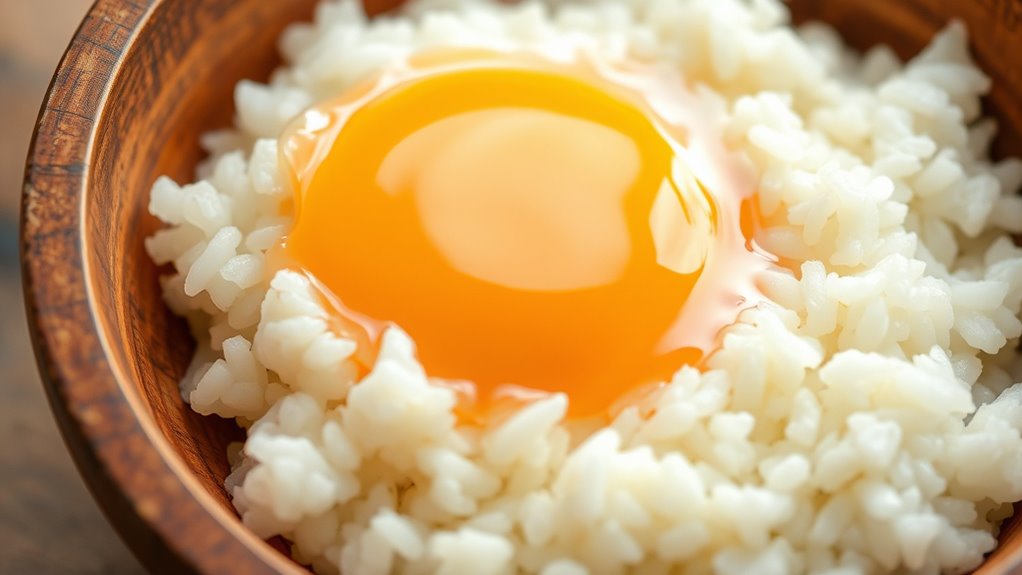
Japanese Tamago Kake Gohan offers a nutritious, protein-rich meal that can be a healthy addition to your diet. The combination of rice and raw egg provides high-quality protein, essential amino acids, and important nutrients like vitamins B12 and D. This meal can boost your energy levels and support muscle repair. However, you should consider the risk of salmonella from raw eggs. To minimize this, use fresh, high-quality eggs and ensure they are stored properly. Additionally, if you have dietary restrictions or need to limit cholesterol, consult your healthcare provider before regularly consuming raw eggs. Overall, Tamago Kake Gohan can be a wholesome, satisfying meal when prepared with care and balanced with other nutrient-dense foods.
How Tamago Kake Gohan Fits Into Modern Japanese Cuisine
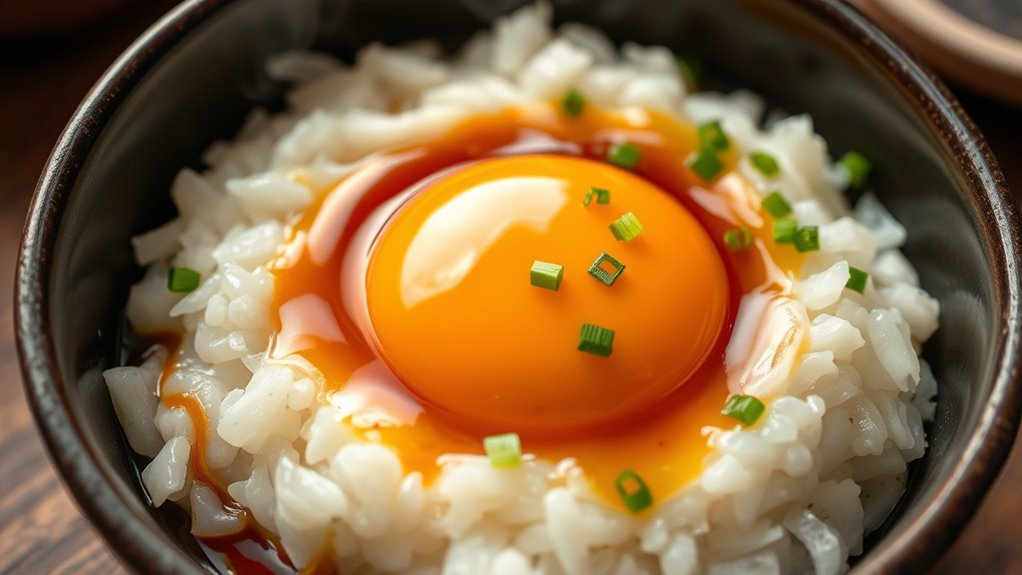
Tamago Kake Gohan seamlessly integrates into modern Japanese cuisine by blending traditional comfort food with contemporary culinary trends. You’ll find it appearing in trendy cafes, fusion restaurants, and home kitchens alike, showcasing its versatility. This dish connects the past with the present, embracing minimalist aesthetics and fresh ingredients. Chefs often experiment with toppings, seasonings, or even upscale rice varieties, making it adaptable to current dining styles. It also appeals to health-conscious consumers, emphasizing simple, wholesome ingredients. As Japanese cuisine evolves globally, Tamago Kake Gohan remains rooted in tradition while embracing innovation. Its popularity highlights how timeless dishes can adapt to modern tastes and lifestyles, ensuring it stays relevant in today’s culinary scene.
- Fusion twists with ingredients like truffle or avocado
- Incorporation into bento boxes and quick meals
- Use of organic or locally sourced rice
Frequently Asked Questions
Can Tamago Kake Gohan Be Made With Brown Rice?
Yes, you can definitely make tamago kake gohan with brown rice. Just cook the brown rice until tender, then transfer it to a bowl. Crack a raw egg over the hot rice, add soy sauce, and stir everything together. The brown rice adds a nutty flavor and extra fiber, making it a healthier twist on the classic dish. Just verify the rice is hot enough to slightly cook the egg for safety.
Is Raw Egg Safe to Eat in This Dish?
Think of raw eggs like a fragile treasure chest—delicate but potentially risky. In this dish, eating raw eggs carries a small chance of Salmonella, which can cause illness. To enjoy it safely, you can use pasteurized eggs or lightly cook the egg before adding it to your rice. This way, you preserve the dish’s creamy texture while protecting your health. Always choose high-quality, fresh eggs for added safety.
Are There Vegan Alternatives to Traditional Tamago Kake Gohan?
You’re wondering if vegan options exist for tamago kake gohan. Yes, you can try tofu scramble or mashed chickpeas as a substitute for raw eggs. These alternatives mimic the creamy texture and protein content while keeping the dish plant-based. Simply season them with soy sauce or sesame oil for added flavor. This way, you enjoy a vegan-friendly version without sacrificing the comforting taste of the traditional dish.
How Do Regional Japanese Differences Affect the Dish?
Regional Japanese differences influence tamago kake gohan by introducing local ingredients and flavors. In some areas, folks prefer using different types of rice or soy sauce, adding regional condiments like wasabi or shiso. Coastal regions might include seafood flavors, while inland areas stick to simpler toppings. These variations reflect local tastes and traditions, making each version unique and personal, giving you a delightful way to experience Japan’s diverse culinary culture.
What Are Common Side Dishes Served With Tamago Kake Gohan?
You might wonder what sides go well with tamago kake gohan. Typically, people enjoy simple accompaniments like pickled vegetables, miso soup, or a side of grilled fish. These dishes complement the creamy, savory rice dish without overpowering it. You can also add some seaweed or scallions for extra flavor. Keep it light and balanced to enhance your meal, making it a satisfying, traditional Japanese breakfast or snack.
Conclusion
As you savor each spoonful of tamago kake gohan, remember it’s more than just comfort—it’s a symbol of Japan’s harmony between simplicity and tradition. This humble dish, like a quiet sunrise, reflects the warmth and patience woven into daily life. Embrace its gentle richness, letting it remind you that beauty often lies in the modest moments, connecting past and present in every bite. Truly, it’s a nourishing embrace of cultural soul.
